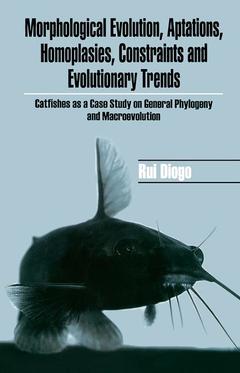Description
Morphological Evolution, Adaptations, Homoplasies, Constraints, and Evolutionary Trends
Catfishes as a Case Study on General Phylogeny & Macroevolution
Author: Diogo Rui
Language: English
Subject for Morphological Evolution, Adaptations, Homoplasies...:
Keywords
Adductor Mandibulae; Posterodorsal Surface; Maxillary Barbel; Present Cladistic Analysis; Levator Operculi; Adductor Operculi; Arrector Ventralis; Anterodorsal Surface; Anteroventral Surface; Dilatator Operculi; Protractor Hyoidei; Lateral Ethmoid; Order Siluriformes; Abductor Superficialis; Pectoral Spine; Higher Level Phylogeny; Nuchal Plate; Adductor Mandibulae A3; Sesamoid Bone; Sister Group Relationship; Pectoral Ray; Pectoral Fin; Pectoral Girdle; Cladistic Analysis; Strict Consensus Cladogram
600 p. · 15.2x22.9 cm · Hardback
Description
/li>Contents
/li>
Catfishes : Introduction: Phylogenetic Position within Teleostei; Catfish Families; Historical Overview of Higher Level Phylogeny of Catfishes; Catfish, an Exceptional Biological Group Methodology & Material: Phylogenetic Methodology; Delimitation of Terminal Taxa; Material, Techniques and Nomenclature Phylogenetic Analysis: Character Description and Comparison; Cladistic Analysis, Diagnosis for Clades, and Comparison with Previous Hypotheses; Character State Changes for Individual Genera; Results of Phylogenetic Analysis: Major Outlines Higher-level Phylogeny and Macroevolution of Catfishes: A Discussion: Structures Associated with Movements of the Mandibular Barbels; Pectoral Girdle Complex; Adductor Mandibulae Complex; Palatine-maxillary System; Suspensorium and Associated Structures; Elastic Spring Apparatus; A Discussion on the Origin and Biogeographic Distribution of Catfishes Catfishes, Case Study for General Discussions of Phylogenetic and Macroevolutionary Topics: Primary Homologies, Secondary Homologies, and a Priori Versus a Posteriori Explanations in Evolutionary Biology; Homoplasies, Consistency Index, and Complexity of Macroevolution; Functional Uncouplings and Morphological Macroevolution; Myological Versus Osteological Characters in Phylogenetic Reconstructions; Analysis of Distinct Anatomical Regions in Phylogenetic Reconstructions; Aptations, Exaptations and Adaptations in Macroevolutionary Studies; Parallelisms, Convergences and Constraints in Macroevolution; Cordelia‘s Dilemma, Historical Bias, and General Evolutionary Trends; Punctuated Equilibrium, Speciation, Living Fossils and Macroevolution




